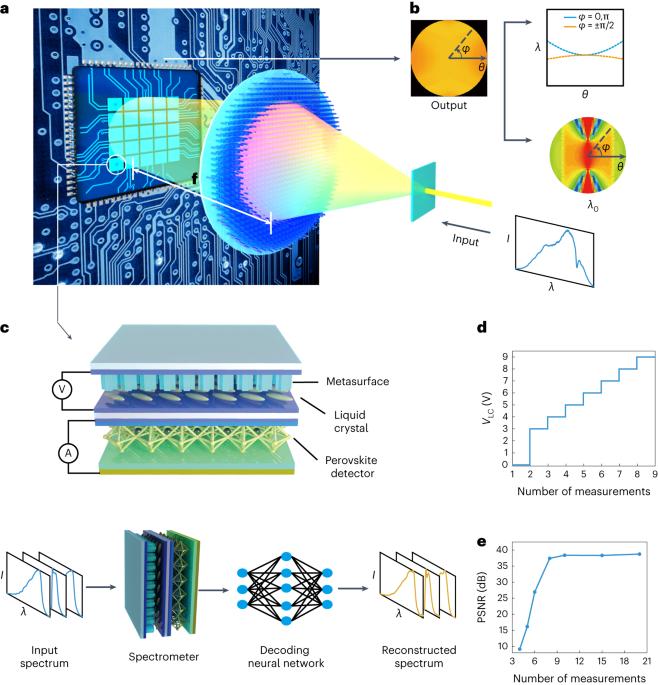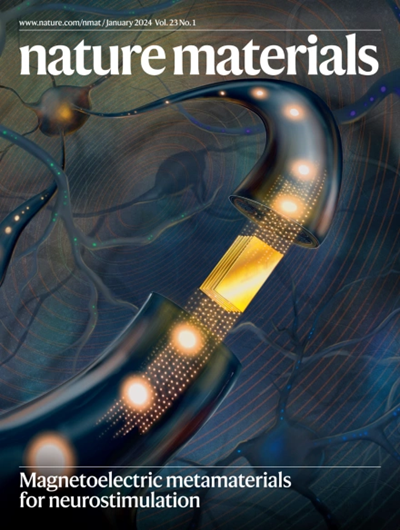Compact angle-resolved metasurface spectrometer
IF 37.2
1区 材料科学
Q1 CHEMISTRY, PHYSICAL
引用次数: 0
Abstract
Light scattered or radiated from a material carries valuable information on the said material. Such information can be uncovered by measuring the light field at different angles and frequencies. However, this technique typically requires a large optical apparatus, hampering the widespread use of angle-resolved spectroscopy beyond the lab. Here we demonstrate compact angle-resolved spectral imaging by combining a tunable metasurface-based spectrometer array and a metalens. With this approach, even with a miniaturized spectrometer footprint of only 4 × 4 μm2, we demonstrate a wavelength accuracy of 0.17 nm, spectral resolution of 0.4 nm and a linear dynamic range of 149 dB. Moreover, our spectrometer has a detection limit of 1.2 fJ, and can be patterned to an array for spectral imaging. Placing such a spectrometer array directly at the back focal plane of a metalens, we achieve an angular resolution of 4.88 × 10−3 rad. Our angle-resolved spectrometers empowered by metalenses can be employed towards enhancing advanced optical imaging and spectral analysis applications. Employing a miniaturized spectrometer that combines a metasurface-based spectrometer array and a metalens, angle-resolved spectral imaging is achieved with a wavelength accuracy of 0.17 nm, spectral resolution of 0.40 nm and angular resolution of 4.88 × 10−3 rad for a spectrometer with a 4 × 4 μm2 footprint.

紧凑型角度分辨超表面光谱仪。
从材料散射或辐射的光在所述材料上携带有价值的信息。这种信息可以通过测量不同角度和频率的光场来发现。然而,这项技术通常需要一个大型光学设备,阻碍了角度分辨光谱在实验室之外的广泛使用。在这里,我们通过将可调谐的基于超表面的光谱仪阵列和金属透镜相结合,展示了紧凑的角度分辨光谱成像。采用这种方法,即使小型化光谱仪的占地面积只有4 × 4. μm2,我们证明了0.17的波长精度 nm,光谱分辨率为0.4 nm和149的线性动态范围 dB。此外,我们的光谱仪的检测极限为1.2 并且可以被图案化为用于光谱成像的阵列。将这样的光谱仪阵列直接放置在金属透镜的后焦平面上,我们获得了4.88的角分辨率 × 10-3 我们的由金属透镜增强的角度分辨光谱仪可用于增强先进的光学成像和光谱分析应用。
本文章由计算机程序翻译,如有差异,请以英文原文为准。
求助全文
约1分钟内获得全文
求助全文
来源期刊

Nature Materials
工程技术-材料科学:综合
CiteScore
62.20
自引率
0.70%
发文量
221
审稿时长
3.2 months
期刊介绍:
Nature Materials is a monthly multi-disciplinary journal aimed at bringing together cutting-edge research across the entire spectrum of materials science and engineering. It covers all applied and fundamental aspects of the synthesis/processing, structure/composition, properties, and performance of materials. The journal recognizes that materials research has an increasing impact on classical disciplines such as physics, chemistry, and biology.
Additionally, Nature Materials provides a forum for the development of a common identity among materials scientists and encourages interdisciplinary collaboration. It takes an integrated and balanced approach to all areas of materials research, fostering the exchange of ideas between scientists involved in different disciplines.
Nature Materials is an invaluable resource for scientists in academia and industry who are active in discovering and developing materials and materials-related concepts. It offers engaging and informative papers of exceptional significance and quality, with the aim of influencing the development of society in the future.
 求助内容:
求助内容: 应助结果提醒方式:
应助结果提醒方式:


